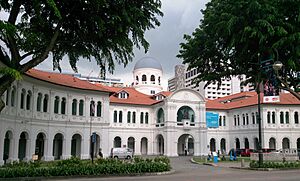Singapore Art Museum facts for kids

Front view of the Singapore Art Museum
|
|
| Former name | Saint Joseph's Institution |
|---|---|
| Established | 20 January 1996 |
| Location | 71 Bras Basah Road, Singapore 189555 |
| Type | Contemporary Art Museum |
| Collections | Singaporean, Southeast Asian and East Asian art |
| Architect | Charles Benedict Nain |
| Public transit access | CC2 Bras Basah DT21 Bencoolen |
The Singapore Art Museum (SAM) is a special art museum in Singapore. It's the first museum in Singapore completely dedicated to modern and new art, called contemporary art. It has one of the most important collections of art by artists from Singapore and Southeast Asia. SAM also works with other art museums around the world to create exciting art shows.
SAM displays art in different places, like the Tanjong Pagar Distripark and its older, historic buildings. It also uses other partner locations across Singapore. The main historic building used to be a school called Saint Joseph’s Institution. Another building, called 'SAM at 8Q', was once the Catholic High School. The museum helps organize the Singapore Biennale, which is a big art event that happens every few years.
Contents
History of the Museum
SAM officially opened on January 20, 1996. It was one of the first art museums in Southeast Asia to have world-class facilities and programs.
The museum was first planned as part of a project by the National Museum of Singapore. The idea was to create five museums in the city. The project for the art museum started by restoring the old St. Joseph's Institution building. This building is very old, about 140 years old, and it cost about S$30 million to fix it up.
The museum first opened its doors to the public on October 20, 1995. One of its first art pieces was a huge, 7-meter-tall Swarovski crystal chandelier. It weighed 325 kilograms and took over three months to make! The Prime Minister of Singapore, Goh Chok Tong, officially opened the museum on January 20, 1996. He hoped the museum would help Singapore become a center for art, culture, and new ideas in Asia and the world.
In 2019, the museum's main heritage buildings closed for a big renovation. This work will help keep the old buildings safe and beautiful. The renovation is expected to be finished in 2026.
In January 2022, SAM opened a new art space at Tanjong Pagar Distripark. This new space has two galleries, a place to eat, and studios for artists to work. The museum continues to hold exhibitions and events at other locations while its main buildings are being renovated.
Artist Programs
The Singapore Art Museum has a special program for artists called a residency. This program started in 2021. It allows artists to live and work at the museum for a period of time. Many famous Asian artists have been part of this program, like Arie Syarifuddin, Bolun Shen, and Charmaine Poh.
Where to Find SAM
SAM at Tanjong Pagar Distripark is in an old port area. It's near other art galleries. You can easily walk to places like Chinatown from there. You can also get there by public buses, the MRT train, or taxis.
SAM's main heritage buildings are in the middle of Singapore's arts and culture area. They are close to many other art schools and centers, like the Nanyang Academy of Fine Arts and LASALLE College of the Arts.
The museum also used to have another building called SAM at 8Q on Queen Street. Both of these older buildings are currently closed for renovation.
Art Collection and Shows
SAM shows art from its own collection, which is called the National Collection. It also has changing exhibitions. This helps visitors see a wide range of modern Asian art. Since 2001, the museum has been collecting art from all over the region. This includes works by artists like Cheo Chai-Hiang and Suzann Victor.
The museum often works with other big art places to create exhibitions. For example, it has worked with the Yokohama Museum of Art and the Museum of Contemporary Art Tokyo. They have also shown works by famous artists like Yayoi Kusama.
SAM regularly organizes modern art exhibitions and events. For example, French artist Stéphane Blanquet has presented his art installations there twice. Another French artist, Emmanuel Guillaud, also showed his installation Until the sun rises in 2011.
Since 2010, SAM has focused more on modern art from Southeast Asia. In 2020, they had an exhibition called Time Passes which showed art by 13 new Singaporean artists. In 2021, they had The Gift, featuring artists from the region like Dolorosa Sinaga and Tang Da Wu.
Art and Different Opinions
Sometimes, artworks can cause discussions or different opinions among people. The museum works to handle these situations carefully. Art can make people think and feel different things, and sometimes this leads to public conversations about what art means.
See also
 In Spanish: Museo de arte de Singapur para niños
In Spanish: Museo de arte de Singapur para niños
- National Gallery Singapore
Literature

